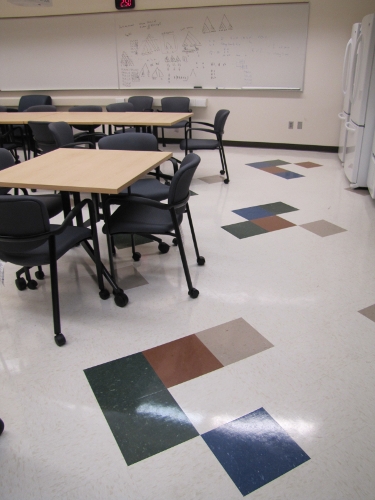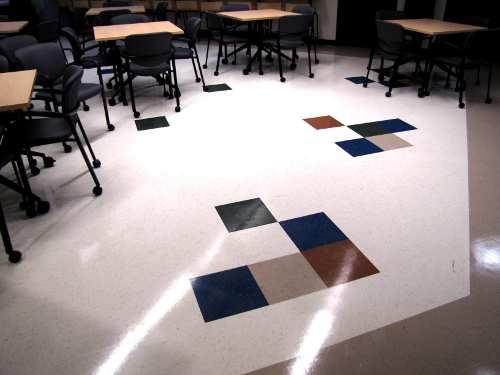
NIMBioS Facilities: The Game of Life
The design of the tile floors in the NIMBioS break rooms is an example of the cellular automaton model called The Game of Life. There are two break rooms at NIMBioS: one for staff and one for visitors; each displays the Game of Life, invented by John H. Conway and publicized in Martin Gardner’s Scientific American column in the fall of 1970.
In the Game of Life, cellular automata are used to model the evolution of generations through discrete time steps using a specified set of rules. These models consist of a group or “neighborhood” of cells on a grid, each cell possessing a particular color representing a state. The states of each cell in the initial generation’s neighborhood must be defined (typically by an integer) in the set of rules.
For example, k=2 could be a binary set representing states “on,” shown by color 0 and “off,” shown by color 1. Subsequent generations are created by evaluating the neighborhood of the current cell, which is defined in the set of rules by a specific range of cells surrounding the current cell.
Conway’s Game of Life is a totalistic cellular automaton, meaning that the rules depend on the average of the values of the cells in the neighborhood. This automaton is modeled on a two-dimensional grid, with 2 states—on and off—and a neighborhood of eight cells immediately adjacent to the current cell . Each cell in the neighborhood is checked to see whether it is on or off, and count of cells that are on is determined. From there, the fate of the current cell is determined based on the following rules:
Death: If the count is less than 2 or greater than 3, the current cell will be off in the next generation.
Survival: if the count is exactly 2 or is exactly 3 and the current cell is on, the current cell will be on again in the next generation
Birth: if the count is exactly 3 and the current cell is off, the current cell will be on in the next generation.
Further resources
Cellular Automaton
Game of Life

NIMBioS
1122 Volunteer Blvd., Suite 106
University of Tennessee
Knoxville,
TN 37996-3410
PH: (865) 974-9334
FAX: (865) 974-9461
Contact NIMBioS


